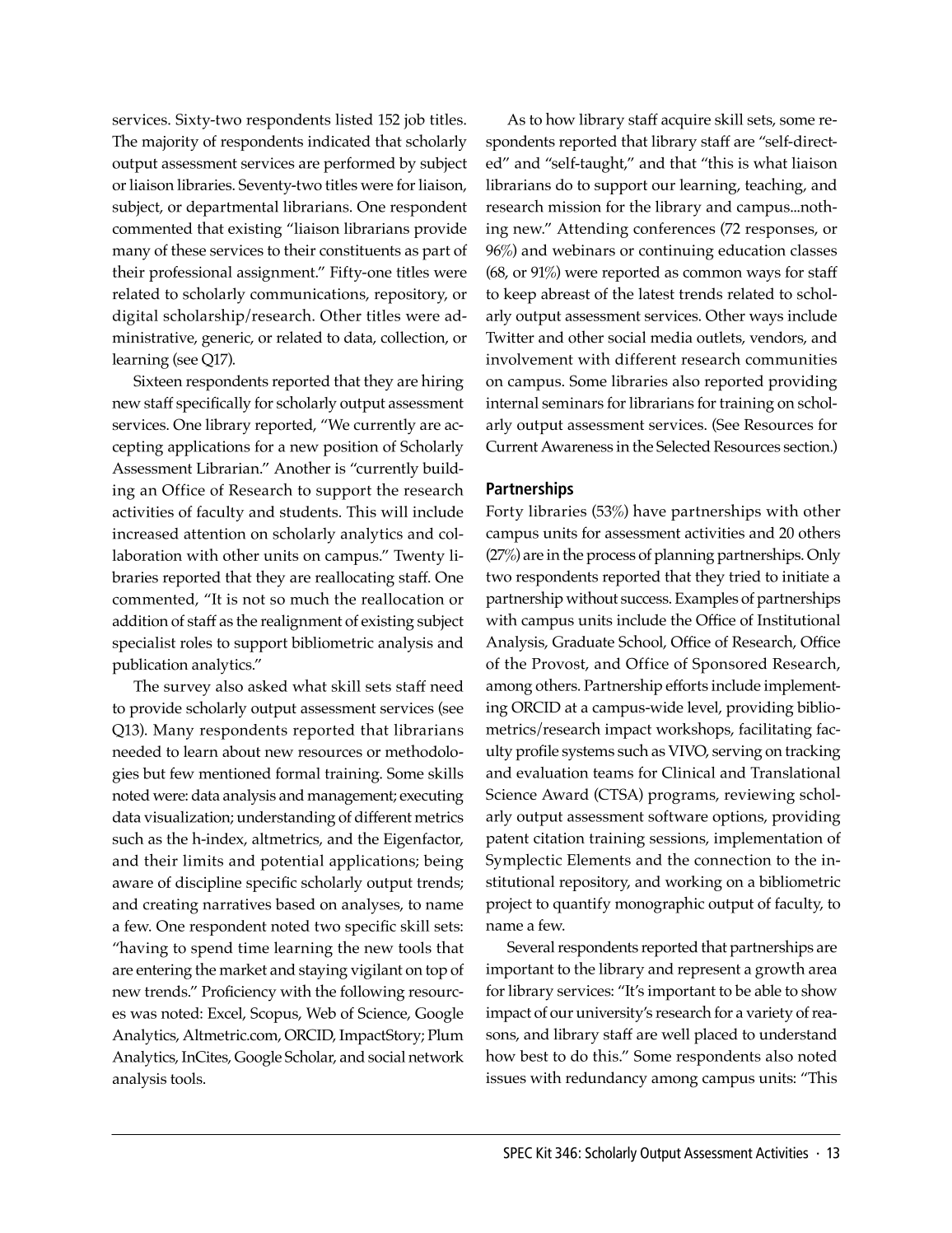SPEC Kit 346: Scholarly Output Assessment Activities · 13
services. Sixty-two respondents listed 152 job titles.
The majority of respondents indicated that scholarly
output assessment services are performed by subject
or liaison libraries. Seventy-two titles were for liaison,
subject, or departmental librarians. One respondent
commented that existing “liaison librarians provide
many of these services to their constituents as part of
their professional assignment.” Fifty-one titles were
related to scholarly communications, repository, or
digital scholarship/research. Other titles were ad-
ministrative, generic, or related to data, collection, or
learning (see Q17).
Sixteen respondents reported that they are hiring
new staff specifically for scholarly output assessment
services. One library reported, “We currently are ac-
cepting applications for a new position of Scholarly
Assessment Librarian.” Another is “currently build-
ing an Office of Research to support the research
activities of faculty and students. This will include
increased attention on scholarly analytics and col-
laboration with other units on campus.” Twenty li-
braries reported that they are reallocating staff. One
commented, “It is not so much the reallocation or
addition of staff as the realignment of existing subject
specialist roles to support bibliometric analysis and
publication analytics.”
The survey also asked what skill sets staff need
to provide scholarly output assessment services (see
Q13). Many respondents reported that librarians
needed to learn about new resources or methodolo-
gies but few mentioned formal training. Some skills
noted were: data analysis and management; executing
data visualization; understanding of different metrics
such as the h-index, altmetrics, and the Eigenfactor,
and their limits and potential applications; being
aware of discipline specific scholarly output trends;
and creating narratives based on analyses, to name
a few. One respondent noted two specific skill sets:
“having to spend time learning the new tools that
are entering the market and staying vigilant on top of
new trends.” Proficiency with the following resourc-
es was noted: Excel, Scopus, Web of Science, Google
Analytics, Altmetric.com, ORCID, ImpactStory; Plum
Analytics, InCites, Google Scholar, and social network
analysis tools.
As to how library staff acquire skill sets, some re-
spondents reported that library staff are “self-direct-
ed” and “self-taught,” and that “this is what liaison
librarians do to support our learning, teaching, and
research mission for the library and campus...noth-
ing new.” Attending conferences (72 responses, or
96%) and webinars or continuing education classes
(68, or 91%) were reported as common ways for staff
to keep abreast of the latest trends related to schol-
arly output assessment services. Other ways include
Twitter and other social media outlets, vendors, and
involvement with different research communities
on campus. Some libraries also reported providing
internal seminars for librarians for training on schol-
arly output assessment services. (See Resources for
Current Awareness in the Selected Resources section.)
Partnerships
Forty libraries (53%) have partnerships with other
campus units for assessment activities and 20 others
(27%) are in the process of planning partnerships. Only
two respondents reported that they tried to initiate a
partnership without success. Examples of partnerships
with campus units include the Office of Institutional
Analysis, Graduate School, Office of Research, Office
of the Provost, and Office of Sponsored Research,
among others. Partnership efforts include implement-
ing ORCID at a campus-wide level, providing biblio-
metrics/research impact workshops, facilitating fac-
ulty profile systems such as VIVO, serving on tracking
and evaluation teams for Clinical and Translational
Science Award (CTSA) programs, reviewing schol-
arly output assessment software options, providing
patent citation training sessions, implementation of
Symplectic Elements and the connection to the in-
stitutional repository, and working on a bibliometric
project to quantify monographic output of faculty, to
name a few.
Several respondents reported that partnerships are
important to the library and represent a growth area
for library services: “It’s important to be able to show
impact of our university’s research for a variety of rea-
sons, and library staff are well placed to understand
how best to do this.” Some respondents also noted
issues with redundancy among campus units: “This




























































































































































































